( – promoted by navajo)
Nearly a thousand years ago, Ancestral Puebloans (sometimes called Anasazi) began to construct pueblos in caves and under the rock hangings of the canyon cliffs in southern Colorado. Three hundred years later, these pueblos were abandoned because of a prolonged drought. Then in 1888, rancher Richard Wetherill and his brother-in-law Charlie Mason came across the ruins of an enormous village in the cliffs of Cliff Canyon. They named the village Cliff Palace. In exploring the area, they discovered two more large ruins which they named Spruce Tree House and Square Tower House.
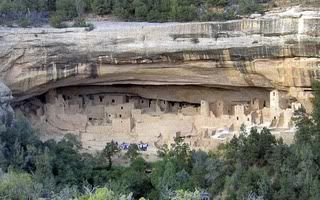
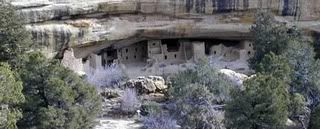
Wetherill and Mason returned to the ruins and dug up a large number of artifacts which they later displayed at the Fair Building in Durango, Colorado.
While Wetherhill and Mason are commonly credited with “discovering” the Mesa Verde ruins, it is important to note that the Utes already knew about the Mesa Verde ruins. Most of ruins lay on Ute lands. The Utes avoided the ruins, which were considered to harbor spirits of the dead that would harm living people.
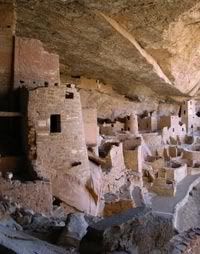
In addition, several non-Indians had also explored the area prior to Wetherhill and Mason. In 1765 Don Juan María de Rivera led an expedition into the area and reported seeing ancient ruins. These may have been the ruins of Mesa Verde, but the report provided no identifiable features.
In 1874, pioneer photographer William Henry Jackson was guided into Two Story House by a local miner. He took the first photographs of a cliff dwelling in the Mesa Verde region. In 1884, another prospector, S. E. Osborn, spent the winter in the area and explored Balcony House.
In 1890, Benjamin Wetherhill wrote to the Smithsonian Institution suggesting that the ruins be made into a national park so that the tourists would not destroy them.
In 1899, a group of women determined to halt the vandalism at the Mesa Verde ruins and to attract tourists to the area held a meeting on the Southern Ute reservation with Ute leaders Ignacio and Acowitz. They suggested that the Ute police the park and proposed a lease of $300 per year. Chief Ignacio demanded $9,000 at one time and the negotiations failed.
President Theodore Roosevelt signed the bill which created Mesa Verde National Park in 1906. This was the first national park created to preserve ancient ruins. Today the park includes 4,000 known archaeological sites which include 600 cliff dwellings.
The initial Act passed by Congress included 42,000 acres of Ute land. However, because of a faulty survey almost none of the ruins were actually located in the new national park. To correct this, the bill was amended to place all unpatented prehistoric ruins on Indian or federal land within five miles of the park boundary under the custodianship of the park.
In 1911, the Indian Service sent its top negotiator, James McLaughlin, to talk with the Ute about the expansion of Mesa Verde National Park. Meeting with 48 members of the Wiminuche Band, McLaughlin explained that a number of cliff dwellings were left out of the park. The park needed just a five mile parcel and the government would give the Ute a larger piece in exchange for it.
One of the interpreters, Nathan King, pointed out to government negotiators that the Ute already owned the land that the government was trying to give them. In addition, the lands which they would be giving up contained valuable springs. The negotiators then told the Ute that the government was strong enough to take the land away from them for the park. Having no choice, the Ute agreed to the transfer. As a result, the Ute gave up an additional 10,800 acres of their land for Mesa Verde National Park and they received 20,160 acres of their own land in exchange.
In 1913, a survey found that the boundary for Mesa Verde National Park excluded Balcony House. Without bothering to notify the Ute, Congress amended legislation to transfer an additional 1,320 acres from the reservation to the park.
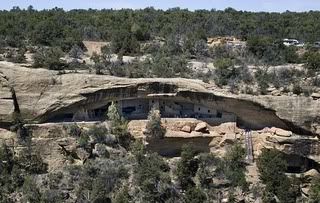
In 1978, Mesa Verde National Park was designated as a World Heritage Site.
In 1986, the Ute took advantage of a surveying error which put part of a well-traveled road in Mesa Verde National Park on tribal lands. They established a facility that offers souvenir and refreshment sales as well as helicopter tours. The National Park Service was not happy with this unregulated facility.
In 2006, 100 years after the National Park was created, 1,500 human remains and nearly 5,000 associated funerary items-pottery, beads, basketry, and other artifacts-that had been excavated from Mesa Verde National Park during the past 100 years were repatriated and reburied at an undisclosed location within the park. The 24 tribes culturally affiliated with the park appointed the Hopi to perform the reburial ceremonies. The repatriation was carried out under the Native American Graves Protection and Repatriation Act (NAGPRA). According to the Mesa Verde National Park website:
http://www.nps.gov/meve/histor…
The reburial ceremony was a result of 12 years of consultation with the park’s 24 associated tribes, and was performed by both park staff and the Hopi tribe. Due to the sensitive nature of the event, and out of respect for the tribes, the reburial was closed to the general public and took place in an undisclosed park location.
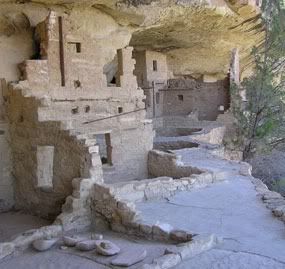
We, my wife and I have been to Mesa Verde twice now. We do enjoy the place. This past summer though we found that the only way to get into many of the sites is on a ranger guided tour. While I can see the purpose of it, with the on going theft of artifacts. It is not the same as wandering through the now vacant cities. The ghosts and spirits can not be heard in a crowd. The peoples voices seem muted or non-existent.
It is a place where people built their community and prospered for a thousand years. It is not just their buildings and cities. But their irrigation and crops and adaptation to life on the plateau. It is a wondrous place.
footsore